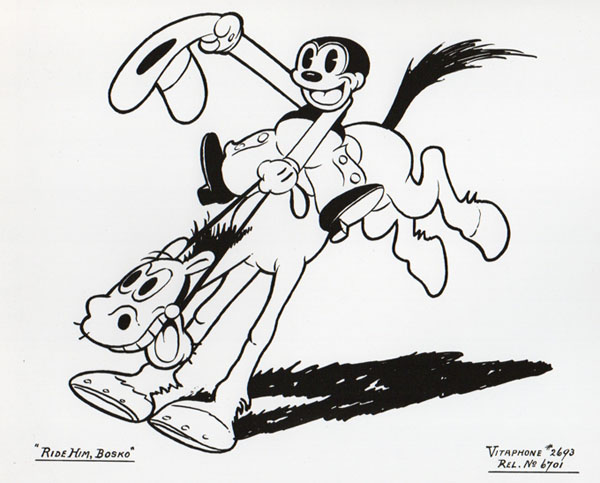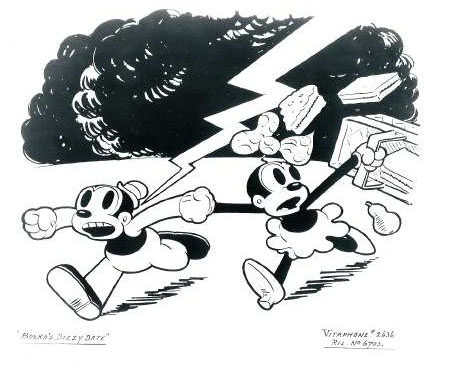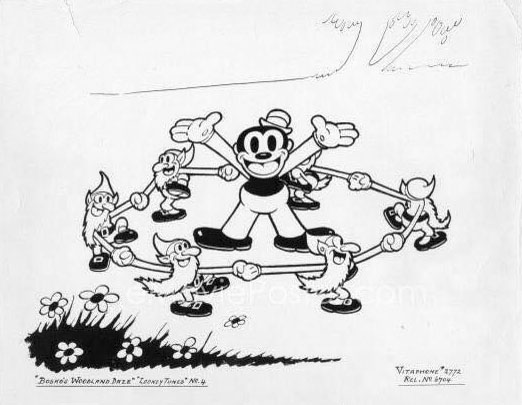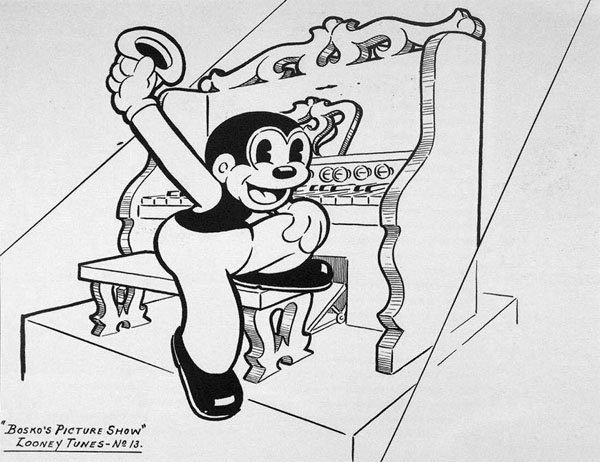
As the 1932-33 film season progressed, exhibitors must certainly have noticed that the mood of the public had grown more optimistic. With an election having just been held, and the prospect of legal booze (starting with beer), the public felt more cheery, and with renewed popularity of movie musicals, there were more opportunities to interpolate songs into both feature films and cartoons.
Things might not have been so rosy at Leon Schlesinger productions. Hugh Harman and Rudolf Ising were about to leave – and take their studio’s most popular character. After a period of doing cartoons that they could job out to various studios, Harman and Ising linked up with MGM – and brought Bosko with them. The last batch of Boskos to roll off the WB reels were the following:

Bosko the Lumberjack (9/3/32) – Lots of lumber camp gags, and the inevitable chase between Bosko and a French-Canadian lumberjack out to snag Honey for himself. Songs include “I Wish I Had Wings”, “What a Life (Trying To Live Without You)”, and ending with “La Marseillaise”, as well as the almost perennial, “How Can You Say No”. Best known version of “What a Life” is by Coon-Sanders Orchestra on Victor.

Ride Him, Bosko (9/17/32) – includes “When the Bloom Is On the Sage”, written by Fred Howard and Nat Vincent, who performed it as “The Happy Chappies” for Columbia in 1930, and also cut by Frank Luther and Carson Robison for Victor in 1930. It would later be recorded by Bing Crosby and “The Foursome”, with “John Scott Trotter’s Frying Pan Five” for Decca, and even later was used as the theme for “Tom Mix and his Ralston Straight-Shooters” on the Mutual Broadcasting System. It was also recorded by Burl Ives in 1961 – and that’s the version we have embed below.
Other tunes used are “She’ll Be Comin’ ‘Round the Mountain”, and “Dog Gone, I’ve Done It”, the latter of which was recorded by the Boswell Sisters for Brunswick. This is a Bosko Western, featuring a rather oddball ending, as we see three of the principal people that worked on it (Harman, Ising, and Friz Freleng) discussing what they see on a screen, and how Bosko should prevail – then giving it up and deciding to go home, leaving Bosko perplexed and reliant on his own resources.
Bosko the Drawback (10/22/32) – Bosko on the football field. Two notable collegiate marches are included on the track – “Fight On” (USC) and the “Notre Dame Victory March”. Other songs include “A Shanty In Old Shanty Town” and “One Step Ahead of My Shadow”. “Shanty” was visited by Ted Lewis on Columbia and Ted Black on Victor.

Bosko’s Dizzy Date (11/19/32) – This cartoon uses much of the footage and plot material from the rejected “Bosko and Honey”. This would be the first Looney Tune to use “Whistle and Blow Your Blues Away” rather than “A Hot Time In the Old Town Tonight” over its opening titles.
Honey is still trying to teach Wilbur “In the Shade of the Old Apple Tree”, but he’s avoiding the key note at the end of the title phrase as if a bomb were lurking at its position. When Honey leaves the room briefly, she finds him switching from violin to dancing on the piano to the tune, “Peter, Peter, Pumpkin Eater”. Wilbur would actually rather be playing cowboy. Songs include, “Meet Me In the Gloaming” and “(We’ve Got To) Put That Sun Back In the Sky”. “Gloaming” was cut by Don Bestor for Victor and Adrian Rollini for the ARC dime store discs.

Bosko’s Woodland Daze (12/17/32) – Songs include “One Step Ahead of My Shadow”, and “My Isle of Golden Dreams”, a 1919 song with a Hawaiian flavor. A departure episode for the series, as Bosko loses himself in slumber beneath a tree and cavorts in an extended dream with elves, fairies, and an evil giant (including giving time for our hero to dance on a giant-sized piano). Bosko almost winds up in a hanburger sandwich – but the strokes of the mustard brush turn out to be Bruno slurping him back to reality.
Bosko In Dutch (1/14/33) – Bosko on skates. He also rescues a couple of adorable creatures from going over a waterfall. Includes the character Goopy Geer, brought over from the Merrie Melodies series. Songs include “Goopy Geer”, “Ach Du Lieber Augustin”, and “It’s Tulip Time in Holland” a 1915 song.
Bosko In Person (2/11/33) – No plot to speak of – just Bosko singing and playing on stage. Songs include “Whistle and Blow Your Blues Away”, and “‘Ello, Baby”, a 1929 song recorded fairly widely, including Waring’s Pennsylvanians of Victor, Hal Kemp on Brunswick, Bert Lown on the cardboard laminated Hit of the Week records, and as a vocal by Eddie Walters on Columbia and the blackfaced comedy-and-song duet Cotton and Morpheus on Brunswick.
Bosko The Speed King (3/25/33) – Songs include “In My Merry Oldsmobile”, and “Meow” (written by Mel B. Kaufman in 1918, and frequently used wherever cats were called for in early talkies – still remembered years later by Carl Stalling for use in at least one Sylvester and Tweety episode). Bosko tries automobile racing here. Notable is a stuttering race-starter – providing a precursor of what would become Porky’s stock-in-trade.
Bosko’s Knight-Mare (6/3/33) – Bosko daydreams of the times when Knights were bold – and eventually gets fired from his position because of it. Songs: “Let’s Put Out the Lights and Go To Sleep”, written by Dietz and Schwartz, a hit the year before and recorded by Paul Whiteman on Victor, Guy Lombardo on Brunswick, and Rudy Vallee on Columbia “Radio” record with a line- drawn picture of the singer on the label. The song also had some popularity in Great Britain, recorded by Lew Stone on English Decca, with singing duties taken up by Al Bowlly. Other tunes featured are two songs from “42nd Street” – the title song, and “Young and Healthy”.

Bosko the Sheep-Herder (6/24/33) – Bosko trudges along to find a little lost sheep. Only one notable song in it – “I Like Mountain Music” – already discussed with relation to the Merrie Melodie of the same title in another post.

Beau Bosko (7/1/33) – Bosko vs. the usual Riffs in a Foreign Legion setting in the Sahara. Only notable song is another use of “La Marseillaise”.
Bosko’s Mechanical Man (7/29/33) – Songs include (again) “One Step Ahead of My Shadow”. “Ain’t We Got Fun”, “I Like Mountain Music”, and “Let’s Put Out the Lights and Go To Sleep”. Plot material has been extensively reviewed by Charles Gardner in We Robots 2: Of Title Bouts and Technocrats, on the Animation Trails subchapter, this website click here.

Bosko’s Picture Show (9/2/33) – Typical program at a movie house run by Bosko, in which he plays the organ (sounding more like a wheezy reed organ than a theatre grand), in a sing along that anticipates the style that would come to be karaoke. Songs include “The Golddigger’s Song (We’re In the Money)”, introduced in and opening Golddiggers of 1933, recorded by Leo Reisman with Fred Astaire for Victor, Ted Lewis on Columbia, and vocal records by the Boswell Sisters on Brunswick and by Dick Powell on Melotone, Perfect, and the other ARC dime store labels. Also featured, “California, Here I Come”, a 1924 hit for Al Jolson on Brunswick, Paul Whiteman on Victor, and the California Ramblers on Columbia, and later recorded by Nat Shilkret and the Victor Orchestra in 1928 and by Claude Hopkins and his Orchestra (a hot black band) for Columbia in 1933.
And, of this cartoon, lest we forget:
Bosko the Musketeer (9/16/33) – I cannot discern use of any notable songs being showcased in this score. Bosko again daydreams after reading “The Three Musketeers”, and gets in trouble for his daydreaming again. Some animation again seems to have found its way into reuse in two-strip color in MGM’s Bosko’s Parlor Pranks.
With one door closing, another door would open. Next time: Buddy!


 James Parten has overcome a congenital visual disability to be acknowledged as an expert on the early history of recorded sound. He has a Broadcasting Certificate (Radio Option) from Los Angeles Valley College, class of 1999. He has also been a fan of animated cartoons since childhood.
James Parten has overcome a congenital visual disability to be acknowledged as an expert on the early history of recorded sound. He has a Broadcasting Certificate (Radio Option) from Los Angeles Valley College, class of 1999. He has also been a fan of animated cartoons since childhood.











































That particular T & S short is 1955’s Tweety’s Circus, in case anyone forgot.
“Me-ow” was actually used in quite a few Sylvester & Tweety cartoons, not just “Tweety’s Circus”: https://www.imdb.com/name/nm3479920
There was also that melody that sounded similar but wasn’t quite the same, which was a Milt Franklyn original melody, heard in “Pizzicato Pussycat”, “A Kiddies’ Kitty”, “Trip for Tat”, and “Tweet Dreams”.
Thanks Ian. That was the only short that popped in my head at the time.
Wonderful music, as always. I only wish Harman and Ising hadn’t reused the animation of Bosko chewing the sandwich with his mouth open quite so often. It’s disgusting!
Bye-bye, Bosko! Bring on Buddy!
I don’t think that was Friz Freleng in the live action segment of Ride Him, Bosko.
It’s actually Earl Duvall at the end who decides for everyone, “Let’s go home…”